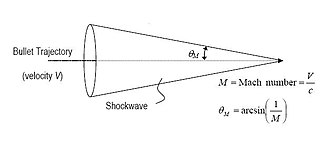Bullet Bang

A projectile bang is locally audible after a projectile has flown past whose flow velocity exceeds the local sound velocity of the surrounding medium - mostly air. The bang is the hearing experience of an abrupt change in pressure, caused by the arrival of a shock wave at the recipient of the sound.
Viewed from a greater distance, this shock wave has approximately the shape of Mach's cone . This is basically pointed, so its opening angle is less than 90 °, since the Mach number of the speed of the projectile flying at supersonic speeds is greater than 1.
When viewed more closely and in the vicinity of the projectile, the shock wave has a roughly rotationally hyperbolic shape and starts at a point a short distance in front of the projectile tip .
The stated angular relationships mean that the bang of a bullet passing by, supersonic, is only heard when it has flown more than 45 ° further from the point of closest approach from the point of view of the observer. However, the shock wave arrives from a direction that is 90 ° "in front of". This is based on the approximate assumption of a straight flight path and straight shock wave propagation.
A second, roughly conical shock wave with a slightly smaller apex angle occurs at the rear of the projectile (or a little behind it). Weaker vortices emanate from the edges of the projectile in particular . So-called Prandtl expansion zones are formed at flatter floor transitions.
An air-diluted space forms behind the floor, in which a Kármán vortex street develops.